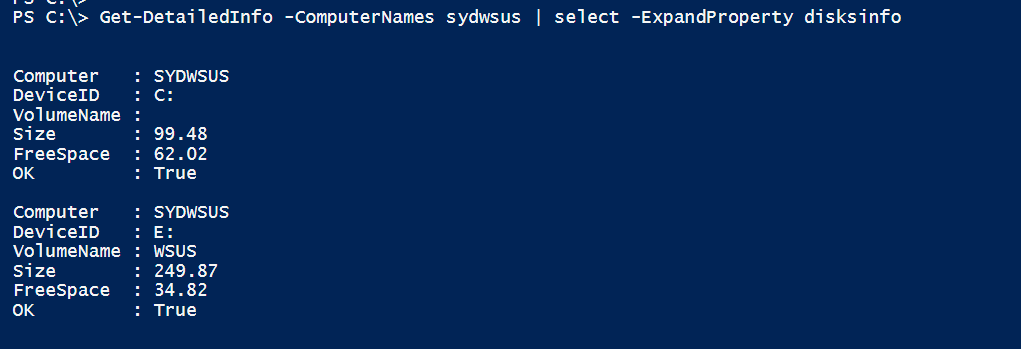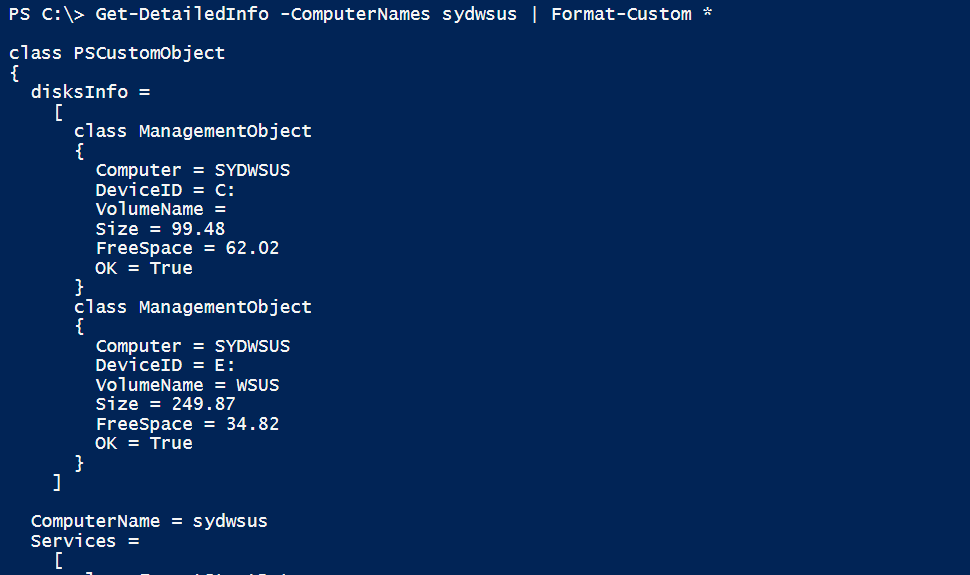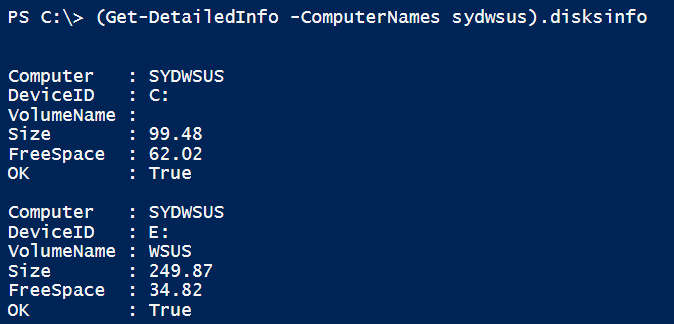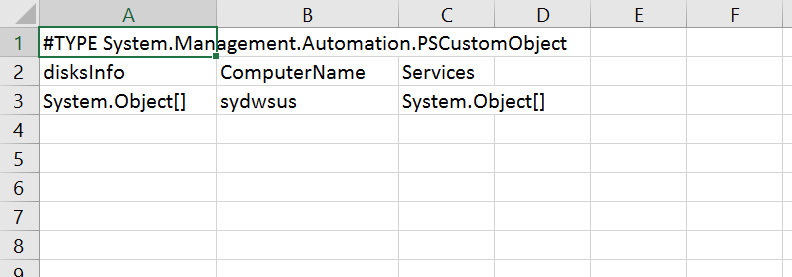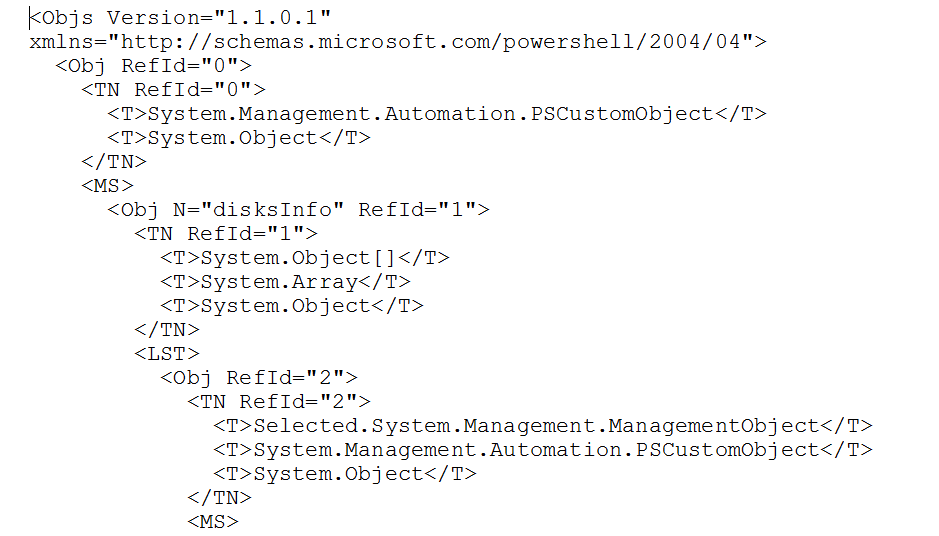PowerShell 创建对象的时候,对象的属性可以是单一属性,也可以在这个属性里面包括多个对象,也就是嵌套的对象属性。
怎么实现嵌套的对象呢,下面看个简单的例子。
首先我写了两个function,分别是获取磁盘信息和服务。
|
1
2
3
4
5
6
7
8
9
10
11
12
13
14
15
16
17
18
19
20
21
22
23
24
25
26
27
28
29
30
31
32
33
34
35
36
37
38
39
40
41
|
Function
Get-DiskInfo
{
[
cmdletbinding
()]
Param
(
[
parameter
(
Mandatory
=
$true
,
ValueFromPipeline
=
$true
)]
[string[]]
$computername
,
[int]
$MinimumFreePercent
=10,
[string]
$errorfile
=
"c:\errors.txt"
)
$disks
=
Get-WmiObject
-Class Win32_Logicaldisk -
Filter
"Drivetype=3"
-ComputerName
$computername
-ErrorAction SilentlyContinue -ErrorVariable err
$result
=
foreach
(
$disk
in
$disks
) {
$perFree
=(
$disk
.FreeSpace/
$disk
.Size)*100;
if
(
$perFree
-ge
$MinimumFreePercent
) {
$OK
=
$True
}
else
{
$OK
=
$False
};
$disk
|Select
@{n=
"Computer"
;e={
$disk
.pscomputername}},DeviceID,VolumeName,`
@{n=
"Size"
;e={
"{0:N2}"
-f
(
$_
.Size/1GB)}},`
@{n=
"FreeSpace"
;e={
"{0:N2}"
-f
(
$_
.Freespace/1GB)}},`
@{Name=
"OK"
;Expression={
$OK
}}
}
$result
if
(
$err
-ne
$null
){
Write-verbose
"There are some errors, please check details from the log files "
$err
|
Out-File
$Errorfile
}
else
{
Write-Verbose
"Complete Successfully"
}
}
function
Get-ComputerService
{
param
(
[string[]]
$computername
=
"localhost"
)
get-wmiobject
-ComputerName
$computername
-Class win32_service -
Filter
"State like 'Running'"
|
select @{n=
"ComputerName"
;e={
$_
.pscomputername}} ,`
name, displayname, Processid, `
@{n=
"Virtual Memory"
;e={
get-process
-id
$_
.processid
|select
-ExpandProperty virtualMemorysize}},`
@{n=
"Peak Page file Usage(M)"
;e={
get-process
-id
$_
.processid
|select
@{n=
"PeakPagedMemorySize(M)"
;e={
"{0:N2}"
-f
(
$_
.PeakPagedMemorySize/1MB)}}| select -ExpandProperty
"PeakPagedMemorySize(M)"
}},`
@{n=
"Threads count"
;e={(
get-process
-id
$_
.processid
|select
-expand threads).count}} | ft
}
|
执行看看
然后我再创建一个新的function,在这个function里面自定义了一个对象,这个对象的disksinfo属性由Get-DiskInfo 创建多个对象;Services属性由Get-computerservice获取多个对象。
|
1
2
3
4
5
6
7
8
9
10
11
12
13
14
|
function
Get-DetailedInfo
{
[
cmdletbinding
()]
param
(
[string[]]
$ComputerNames
)
foreach
(
$computername
in
$computernames
){
$disks
=
get-diskinfo
-computername
$ComputerName
$service
=
Get-ComputerService
-computername
$ComputerName
$props
=@{
'ComputerName'
=
$computerName
;
'disksInfo'
=
$disks
;
'Services'
=
$service
}
$obj
=
New-Object
-TypeName psobject -Property
$props
$obj
}
}
|
然后我们看看结果, 可以看见对应的属性本身就包括了多个对象。
这样的话,创建嵌套的对象是成功了,但是看起来很不方便。如果我想查看对应的disksinfo怎么办,一般可以通过以下几种方式查看。
1. select -expand 这个可以把整个数组对象的内容扩展开来,同时还能自动转换成字符串类型
|
1
|
Get-DetailedInfo
-ComputerNames sydwsus | select -ExpandProperty disksinfo
|
2.Format-custom 这个会展示整个对象的结构
|
1
|
Get-DetailedInfo
-ComputerNames sydwsus |
Format-Custom
*
|
3. 手动的循环展开也是可以的
|
1
|
Get-DetailedInfo
-ComputerNames sydwsus |
foreach
{
$_
.disksInfo}
|
4. PowerShell3 以后的版本也可以直接当做数组处理~
|
1
|
(
Get-DetailedInfo
-ComputerNames sydwsus).disksinfo
|
现在可以查看了,如何把整个结果保存下来呢?
传统的很多习惯是保存为csv格式,我们来试试
|
1
|
Get-DetailedInfo
-ComputerName sydwsus |
Export-Csv
c:\temp\info.csv
|
打开确认一下 额 这是怎么回事?
CSV文件这种平面的结构是无法显示多重深度的对象的,因此他只能显示个对象类型,意思就是这个类型有多个对象需要显示,但是我没法在CSV里面显示出来。
那应该怎么处理呢?这里适合使用xml文件。
比如说
|
1
|
Get-DetailedInfo
-ComputerName sydwsus |
Export-Clixml
c:\temp\info.xml
|
这样就可以保存了。
本文转自 beanxyz 51CTO博客,原文链接:http://blog.51cto.com/beanxyz/1782988,如需转载请自行联系原作者


